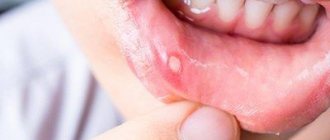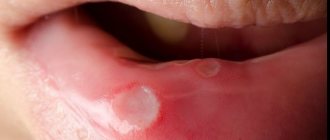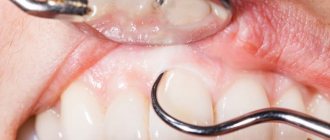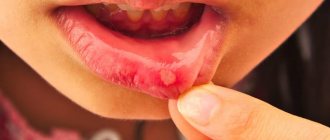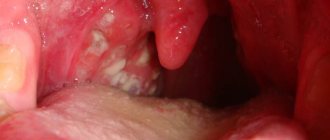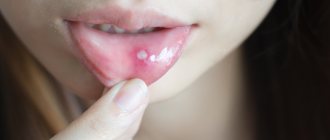About the prevention and treatment of common childhood dental diseases, the causes of candidiasis (thrush) and stomatitis. How can I help my child maintain oral hygiene? Note to parents.
Every parent, when visiting a pediatric dentist, wonders when can they start brushing their teeth? There are many opinions on this matter; some even argue that it is not necessary to clean dairy products. But this is a mistaken opinion. It is known that dental plaque contains pathogenic microorganisms that contribute to the occurrence of caries. It is necessary to accustom your child to brushing his teeth from the age of one. At first, the parent takes care of this himself, and later controls the process. By the age of one year, on average, a child has 8 to 12 teeth. If parents find it difficult to use a toothbrush, you can clean off plaque with gauze wrapped around your finger. This will reduce the trauma that can occur from a toothbrush, because... the child does not immediately begin to understand the meaning of this process. Later, you can start brushing with a soft-bristled toothbrush; you can find one in every pharmacy. There is a variety of choices, both in terms of external indicators and age.
Children's pastes are also varied. You can consult your dentist about your choice. When a child begins to brush his teeth on his own, parents should supervise this process, because children often do it in bad faith, for a short time. It is recommended to clean for up to 5 minutes, removing plaque from top to bottom.
Even despite hygiene, the child is not insured against such childhood diseases as candidiasis and stomatitis. Outwardly they are very similar, parents often confuse them. How to distinguish them and how to treat them?
Causes of thrush in a child’s mouth
The disease can appear in infants literally from birth - in the first week of life. Its causative agent is the yeast-like fungus Candida. This fungus lives in the body constantly and, with good immunity, does not cause any harm, but when some disruptions occur, the disease develops, and then treatment for candidal stomatitis in children cannot be avoided.
The disease can be caused by:
- vaginal candidiasis of the mother (the child becomes infected with the fungus while passing through the birth canal);
- long-term use of antibiotics;
- the presence of any diseases, for example, ARVI;
- teething;
- improper oral hygiene of the baby or lack thereof.
Regardless of the causes of formation, treatment of thrush in newborns should be carried out under the supervision of a medical specialist.
Stomatitis
Stomatitis in a child
There are several types of stomatitis, the most common are herpetic and aphthous . It differs from candidiasis in that it is accompanied by high fever. Bubbles and aphthae appear on the tongue, soft palate, and gums. The child stops eating due to severe pain. Most often, children in kindergartens suffer from stomatitis. They are constantly in contact and put toys in their mouths. If one child gets sick with viral stomatitis, the other is more likely to get infected from him. One of the reasons for refusing a pacifier is not only a violation in the formation of the bite, but also hygiene. Repeatedly, infection occurs from a child who brought a pacifier to kindergarten and lent it to his friends. Reduced immunity can provoke the disease; if relapses occur, laboratory tests are prescribed to rule out common diseases.
Treatment
Treatment for general symptoms of stomatitis is prescribed by a local pediatrician and locally by a pediatric dentist. It includes treating aphthae with sea buckthorn oil, some recommend an aqueous solution of blue, before eating they recommend painkillers gels, soda gargles, and spraying the throat with aerosols. As a rule, stomatitis disappears suddenly, just as it began, and good immunity copes with the disease.
Every parent faced with such problems panics.
These diseases are treated almost every day. This is not a reason to worry, because... everything is treated in a short time, and maintaining hygiene, monitoring the child’s behavior, weaning from bad habits completely eliminates these problems. Moscow metro station Zvezdnaya, Danube Avenue, 23
Symptoms of stomatitis in newborns
As a rule, candidal stomatitis in children begins asymptomatically, so the child does not show concern. As the disease progresses, his behavior changes - the baby refuses to eat and becomes capricious. Due to the active proliferation of the fungus, the taste of food changes, which may explain the lack of appetite.
Pronounced signs that treatment of candidal stomatitis is required in children are:
- a whitish, cheesy coating in the oral cavity - it is especially clearly visible in the morning, after waking up;
- sour breath;
- swelling and redness of the gums.
Candidal stomatitis in children has three degrees of severity. In mild and moderate forms of the disease, the white coating is easily removed, but at the same time areas of bright red mucous membranes are exposed. In severe form, the plaque is already denser. And since it is fused to the mucous membrane, it is quite difficult to remove. And if this succeeds, an eroded mucous membrane with bruises opens. Thrush in a baby’s mouth is usually clearly visible in the early stages, so prompt consultation with a doctor can prevent the development of complications.
Treatment of candidal stomatitis in children must be started in a timely manner, otherwise complications in the form of a secondary infection and the gradual spread of the fungus throughout the child’s body cannot be avoided.
Candidal stomatitis can be identified by the symptoms in the following photos:
Symptoms of the disease
As a rule, the highest concentration of fungus is found on the surface of the inside of the cheeks, tongue, pharynx and tonsils, and palate. At an early stage of the development of the disease in children, redness of the mucous membranes is observed; they become swollen, the sensitivity of the mucous membrane increases, which is why children are often irritable, capricious, and their appetite and sleep are disturbed. The primary episode of the disease usually occurs in a more acute form; Patients may experience general symptoms: fever, headaches and dizziness, nausea or vomiting, deterioration in general health.
Some time after the onset of the disease, white grains begin to appear on the surface of the mucous membranes of the oral cavity, which gradually increase in size and merge together, forming plaques, and then plaque covering large areas of the mucosa. During this stage, patients suffer from severe dryness and swelling in the mouth. The mucous membranes become painful. Burning, itching and other unpleasant sensations are most often associated with the development of an allergic reaction caused by the proliferation of pathogenic microorganisms and the release of toxins during their life processes. The pain intensifies when eating and swallowing food, when eating hot, sour, spicy foods and drinks. Infants often refuse to eat.
The plaque formed during candidiasis has a very characteristic appearance and resembles milk films or remains of cottage cheese. It consists of destroyed cells of the mucous membranes, food debris, bacterial mass, fibrin and keratin. Flakes, scales and plaque can also appear outside the mouth - on the edges of the lips. The spread of infection to the lips is called candidiasis. Because of this disease, the skin in the corners of the lips dries out and cracks; In some cases, the infection affects the entire surface of the lips, resulting in cracking and peeling.
In mild and moderate forms of the disease, plaque is easily scraped off, and underneath it, areas of erosion (ulceration) or maceration (softening) of the mucous membrane are found. A longer course of the disease and the lack of adequate treatment leads to deep damage to the mucous membranes, as a result of which blood appears on their surface, turning the plaque brown or brownish.
Clinical treatment
The success of treatment of candidal stomatitis in children can only be said if all sources of infection have been completely eliminated. When the cause of oral disease is the use of antibiotics, in parallel with general treatment, a course of antifungal therapy may be prescribed.
The principle of treating candidal stomatitis in children comes down to creating an alkaline environment in the oral cavity - it is this pH value that is detrimental to fungi. In addition, in an alkaline environment, most pathological microorganisms die, including those that cause carious tooth decay.
The child’s oral cavity can be treated with a solution of baking soda (the optimal concentration will be determined by the attending physician). The procedure for treating candidal stomatitis in children is quite simple: a gauze swab soaked in a solution is used to treat the oral mucosa of the gums and cheeks.
In severe cases, your dentist may prescribe oral medications.
The Doka-Dent dental clinic provides quick and safe diagnostics for effective treatment of stomatitis in infants and older children. Branches in Moscow are located at two addresses:
- Teply Stan district, Leninsky Prospekt, building 131, 1st and 2nd floor. One minute from Troparevo metro station in a building located between Leninsky Prospekt and Academician Bakulev Street.
- Tverskoy district, 1st Tverskaya-Yamskaya, building 27, 2nd floor. Three minutes from any exit from Belorusskaya station in a building located between the first Tverskaya-Yamskaya and the first Brestskaya streets.
Specialists from both clinics conduct examinations free of charge and help urgently prevent the development of complications and the spread of the disease!
Candidal stomatitis in children, symptoms and treatment
Candidal stomatitis, or fungal stomatitis, or thrush is the most common type of inflammation of the oral cavity in children. Although it is more common in young children, children of all age groups are not immune from the development of a cheesy coating with a rather unpleasant odor on the mucous membranes and tongue.
The causative agent of this type of inflammation is the Candida fungus, which is present in the microflora of the oral cavity, but some unfavorable factors can provoke its rapid proliferation and, as a result, candidiasis - inflammation of the mucous membrane.
Candidiasis is stomatitis on a child’s tongue and on the inside of the cheeks and lips, which is accompanied by severe pain and itching. Sometimes hyperemia (redness) and plaque spreads to the pharynx. Candida plaque is easily removed, revealing brightly colored erosions underneath. There is one popular misconception that if you take a bandage with powdered sugar (or honey) and remove the plaque, the thrush will go away. Yes, the plaque is removed, but the sharp microparticles of sugar injure the mucous membrane in new places and the microwounds immediately become infected with fungus. After some time, stomatitis returns in an even greater volume, since sweets serve as an excellent breeding ground for fungus, as well as various bacteria, so such self-medication can also result in infectious stomatitis in addition.
If your baby has inflammation in the mouth, immediately contact the experienced specialists of the Utkinzub clinic and they will determine the type of stomatitis and prescribe the appropriate treatment. And now we will tell you how to quickly cure stomatitis of fungal origin under the supervision of our doctors.
How to treat oral stomatitis
Treatment of candidiasis is carried out in two directions - local therapy and general treatment. It is known that all fungal diseases actively develop in an acidic environment, which means that in order to limit the spread, the pH in the mouth should be changed. You can alkalize the environment in the oral cavity using a soda solution or a 2% boric acid solution. Often, for children over 3 years old, lubrication with aniline dyes, in particular methylene blue, is used. of candidal stomatitis in infants has its own characteristics, which you can read about in the article “ Treatment of stomatitis in infants . You should rinse your mouth with alkaline solutions several times a day, or wipe the gums of the necks of your teeth, where harmful fungus is most often hidden in plaque. The doctor will prescribe a special solution for the treatment of Candide stomatitis, which destroys the fungus. The duration of use of the drug is strictly 10 days; you cannot stop treatment, even if there is no longer visible thrush, since the fungus may not be completely eliminated, and if it returns, it will be resistant to the drug and difficult to cure.
Older children can be prescribed Diflucan, but in a strictly individual dosage, determined by the doctor. The use of special antifungal ointments is also mandatory; vitamin complexes and immunomodulators will be prescribed to enhance immunity. After treatment, the teeth will be sanitized and the child will be taught the rules of oral hygiene. If thrush persistently returns, then other family members who can constantly infect the child should be examined. A sick child must be immediately isolated from other children, given a separate room, dishes and a towel, because candidal stomatitis is quite contagious. Complex forms of candidiasis are treated with antifungal medications, sometimes in the form of injections. The prognosis is good and a complete cure is possible.
Stages of development of candidal stomatitis
Treatment of candidal stomatitis depends on the degree of its progression. The entire disease can be divided into several stages based on its symptoms, depending on how late it is detected:
- Stage one. The mildest symptoms of oral candidiasis are the appearance of red sores on the mucous membranes: cheeks, lips, as well as on the gums, tongue and tonsils. At this stage, treatment of candidal stomatitis is difficult due to the fact that the disease is still barely noticeable and may not cause serious discomfort, which is why the patient does not see a doctor. The first stage can last quite a long time and not develop into subsequent ones.
- Stage two. A white cheesy coating appears at the sites of the ulcers, which can be removed. When scraped, red and rather painful wounds form at the site of the ulcers. At this stage, the temperature may rise, but only slightly and quite rarely.
- Stage three. The white cheesy coating becomes very difficult to scrape off, the wounds bleed and hurt a lot. This period is dangerous because microorganisms can get into bleeding wounds, which will cause bacterial stomatitis, the course of which is more severe and is accompanied by a very high temperature.
- Stage four. Severe form of candidal stomatitis, requiring immediate action. The upper respiratory tract may be affected, so only a specialist can determine how exactly to treat candidal stomatitis. At this stage, the disease is very dangerous for children.
In addition, it is also important to know that candidal stomatitis is a contagious disease that is transmitted through kissing and even through sharing utensils. We recommend that you undergo full treatment for candidal stomatitis and avoid such contact with other people during your illness.

